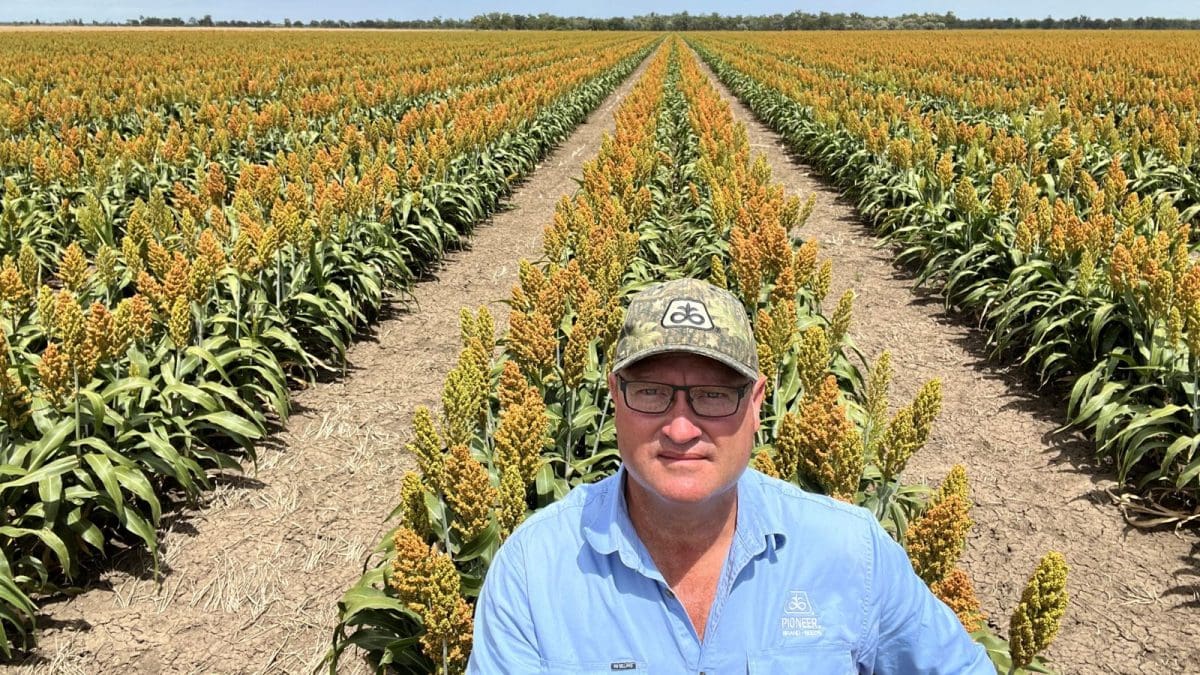
Pioneer farm services consultant Rhino Kramer with an A88 sorghum crop near Moree. Photo: Pioneer Seeds
PRICES for feedgrain in the northern region are under some supply-side pressure as the sorghum harvest gets off to a slow start, while the southern market is trading mostly sideways.
Some bearish news has hit the market today with Viterra Australia forecasting the national wheat crop now in the final stages of harvest will weigh in at 41 million tonnes.
This compares with ABARES estimate of 36.6Mt, also a record.
Estimates for the 2021-22 crop sit at 36.3Mt from ABARES and 38Mt from Viterra.
Australia’s three biggest bulk handlers – CBH Group in Western Australia, Viterra based in South Australia, and GrainCorp in eastern states – have now ended their weekly reports from the 2022-23 harvest.
| Today | Jan 25 | |
| Barley Downs | $400 | $410 |
| SFW wheat Downs | $390 | $395 |
| Sorghum Downs | $400 | $405 |
| Barley Melbourne | $370 | $368 |
| ASW Melbourne | $412 | $412 |
| SFW Melbourne | $410 | $408 |
Table 1: Indicative prices in Australian dollars per tonne.
North softens
Early sorghum crops in New South Wales and southern Queensland are reaching maturity, and a handful of growers north of the border are into harvest.
Volume is expected to ramp up in the next fortnight, and Chinese demand has put sorghum prices at evens with wheat on a delivered Downs basis.
It means the red grain has effectively priced itself out of all but specialty poultry rations.
“If the wheat market was to rally, sorghum would become of interest,” one trader said, adding that a dive in sorghum prices could also spark interest from the domestic stockfeed market.
Apart from one cargo now loading in Newcastle and headed for Japan, sorghum has not got a slot in shipping stems in coming weeks, and local prices could well come under pressure as northern exporters concentrate on wheat.
“There’s only so much you can put through port and boxes.”
In its January data, USDA stuck to its forecast for the sorghum crop grown in the year to September 30 of 2.9Mt, well up on the ABARES figure forecast in December of 2.6Mt.
USDA forecasts Australia’s 2022-23 sorghum exports at 2.4Mt, up from 2.27Mt seen in 2021-22.
Domestic consumers in the north this week are primarily buying SFW and ASW wheat, which is in plentiful supply.
“Test weight’s everything for wheat, and what we’re seeing is largely good quality.
“I think the farmer is engaged in the market, and active in all grades.”
This follows last month’s steady selling from growers, which has trade ticking away at “fair liquidity”.
“For January, we saw a fair amount of fertiliser come out of the port for cotton and sorghum crops, and there was a willingness for the grower to engage with wheat to Newcastle.
In the new-crop cottonseed market, Woodside Commodities principal Hamish Steele-Park said values have firmed since the New Year by $30/t.
“Support is being generated from a lack of offers, and export inquiry is still a feature,” Mr Steele-Park said.
“Spot values, however, have not changed much over the same period, but the price inverse has narrowed between old-crop and current-crop.
The ex Moree spot market is sitting at around $410/t, well above the new-crop market at $395/t for gin spread 2023.
The delivered Downs prompt cottonseed market is quoted at $475-$480/t, compared with new-crop at $455-$460/t gin spread.
Queensland rainfall in the week to 9am includes: Capella 26mm; Dalby 7mm; Emerald 62mm; Miles 14mm; Oakey 27mm; St George 31mm; Springsure 15mm.
In northern NSW, registrations include: Moree 90mm; Narrabri 64mm; Mungindi 20mm; Quirindi 23mm, and Walgett 11mm.
The rain has been welcomed, as many sorghum and dryland cotton crops were or are in dire need of a drink to preserve yield potential.
In Central Queensland, falls have been ideally timed for the sorghum crop now being planted.
Pace pick-up expected in south
GeoCommodities broker Brad Knight said bids have firmed up on lower quality grades, indicating some traders and consumers underestimated the export demand for feed wheat in early-season cargoes.
“The bid side is firmer on those lower quality grades; a lot of early wheat vessels have been feed more than milling,” Mr Knight said.
“Grower selling on lower grades has been quite slow.”
Growers across southern Australia are now starting to book fertiliser to get on to their paddocks ahead of winter-crop planting which is expected to kick off late next month.
This will boost traded grain volumes as fertiliser is picked up from port as a backload for grain delivered to exporters or consumers.
“We’re seeing a bit of that activity this week.”
Some growers in south-west Victoria and South East South Australia are still harvesting, and one source has described the cash market as “incredibly slow”.
This has been put down to the drawn-out harvest, and a number of growers being on family holidays into late January, when they are normally home from the break by the middle of the month.
Weather-damaged faba beans continue to factor into rations at maximum inclusion rates, and at prices similar to SFW wheat.
“At 24pc protein, faba beans will displace some soymeal and wheat in the ration.”
Grain Central: Get our free news straight to your inbox – Click here

HAVE YOUR SAY